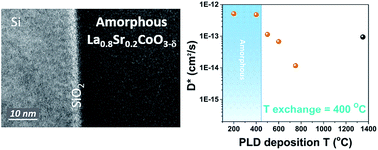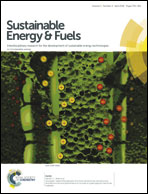Amorphous-cathode-route towards low temperature SOFC†
Abstract
Lowering the operating temperature of solid oxide fuel cell (SOFC) devices is one of the major challenges limiting the industrial breakthrough of this technology. In this study we explore a novel approach to electrode preparation employing amorphous cathode materials. La0.8Sr0.2CoO3−δ dense films have been deposited at different temperatures using pulsed laser deposition on silicon substrates. Depending on the deposition temperature, textured polycrystalline or amorphous films have been obtained. Isotope exchange depth profiling experiments reveal that the oxygen diffusion coefficient of the amorphous film increased more than four times with respect to the crystalline materials and was accompanied by an increase of the surface exchange coefficient. No differences in the surface chemical composition between amorphous and crystalline samples were observed. Remarkably, even if the electronic conductivities measured by the Van Der Pauw method indicate that the conductivity of the amorphous material was reduced, the overall catalytic properties of the cathode itself were not affected. This finding suggests that the rate limiting step is the oxygen mobility and that the local electronic conductivity in the amorphous cathode surface is enough to preserve its catalytic properties. Different cathode materials have also been tested to prove the more general applicability of the amorphous-cathode route.



 Please wait while we load your content...
Please wait while we load your content...